Subcellular Localization of Thioredoxin/Thioredoxin Reductase System—A Missing Link in Endoplasmic Reticulum Redox Balance
Abstract
1. Introduction
2. Results
2.1. In Silico Analysis of Trx/TrxR Localization with Different Prediction Tools
2.2. Activity of TrxR in Subcellular Compartments of Rat Liver
2.3. Expression of Trx/TrxR Isoforms in Subcellular Compartments of Rat Liver
2.4. None of the Trx/TrxR Isoforms Co-Localizes with ER Marker Protein Grp94
2.5. ER-Targeted Expression of Trx1/TrxR1 in HeLa Cells Severely Compromised Cell Viability and Induced Apoptotic Cell Death
3. Discussion
4. Materials and Methods
4.1. In Silico Analysis
4.2. Animals
4.3. Preparation of Subcellular Fractions from Rat Liver Tissue
4.4. Measurement of Thioredoxin Reductase Activity
4.5. Sodium Dodecyl Sulphate Polyacrilamide Gel Electrophoresis (SDS-PAGE) and Western Blot Analysis
4.6. Cell Culture and Maintenance
4.7. Immunofluorescent Analysis of Human Fibroblast and HeLa Cells
4.8. Brightfield Microscopy of HeLa Cells
4.9. Plasmid Design and Construction
4.10. Transient Co-Transfection of HeLa Cells
4.11. Cell Viability Assay
4.12. Statistical Analysis
5. Conclusions
Supplementary Materials
Author Contributions
Funding
Institutional Review Board Statement
Informed Consent Statement
Data Availability Statement
Acknowledgments
Conflicts of Interest
References
- Száraz, P.; Bánhegyi, G.; Benedetti, A. Altered redox state of luminal pyridine nucleotides facilitates the sensitivity towards oxidative injury and leads to endoplasmic reticulum stress dependent autophagy in HepG2 cells. Int. J. Biochem. Cell Biol. 2010, 42, 157–166. [Google Scholar] [CrossRef]
- Foster, C.A.; Mick, G.J.; Wang, X.; McCormick, K. Evidence that adrenal hexose-6-phosphate dehydrogenase can effect microsomal P450 cytochrome steroidogenic enzymes. Biochim. Biophys. Acta 2013, 1833, 2039–2044. [Google Scholar] [CrossRef][Green Version]
- Zhu, H.; Larade, K.; Jackson, T.A.; Xie, J.; Ladoux, A.; Acker, H.; Berchner-Pfannschmidt, U.; Fandrey, J.; Cross, A.R.; Lukat-Rodgers, G.S.; et al. NCB5OR is a novel soluble NAD(P)H reductase localized in the endoplasmic reticulum. J. Biol. Chem. 2004, 279, 30316–30325. [Google Scholar] [CrossRef]
- Bublitz, C.; Lawler, C.A. The levels of nicotinamide nucleotides in liver microsomes and their possible significance to the function of hexose phosphate dehydrogenase. Biochem. J. 1987, 245, 263–267. [Google Scholar] [CrossRef]
- Csala, M.; Margittai, E.; Bánhegyi, G. Redox control of endoplasmic reticulum function. Antioxid. Redox Signal. 2010, 13, 77–108. [Google Scholar] [CrossRef]
- Bass, R.; Ruddock, L.W.; Klappa, P.; Freedman, R.B. A Major Fraction of Endoplasmic Reticulum-located Glutathione Is Present as Mixed Disulfides with Protein. J. Biol. Chem. 2004, 279, 5257–5262. [Google Scholar] [CrossRef]
- Dixon, B.M.; Heath, S.H.; Kim, R.; Suh, J.H.; Hagen, T.M. Assessment of endoplasmic reticulum glutathione redox status is confounded by extensive ex vivo oxidation. Antioxid. Redox Signal. 2008, 10, 963–972. [Google Scholar] [CrossRef]
- Hwang, C.; Sinskey, A.J.; Lodish, H.F. Oxidized redox state of glutathione in the endoplasmic reticulum. Science 1992, 257, 1496–1502. [Google Scholar] [CrossRef]
- Piccirella, S.; Czegle, I.; Lizák, B.; Margittai, É.; Senesi, S.; Papp, E.; Csala, M.; Fulceri, R.; Csermely, P.; Mandl, J.; et al. Uncoupled redox systems in the lumen of the endoplasmic reticulum: Pyridine nucleotides stay reduced in an oxidative environment. J. Biol. Chem. 2006, 281, 4671–4677. [Google Scholar] [CrossRef]
- Margittai, É.; Enyedi, B.; Csala, M.; Geiszt, M.; Bánhegyi, G. Composition of the redox environment of the endoplasmic reticulum and sources of hydrogen peroxide. Free Radic. Biol. Med. 2015, 83, 331–340. [Google Scholar] [CrossRef]
- Hino, Y.; Ishio, S.; Minakami, S. Glucose-6-phosphate oxidation pathway in rat-liver microsomal vesicles. Stimulation under oxidative stress. Eur. J. Biochem. 1987, 165, 195–199. [Google Scholar] [CrossRef]
- Mustacich, D.; Powis, G. Thioredoxin reductase. Biochem. J. 2000, 346, 1–8. [Google Scholar] [CrossRef] [PubMed]
- Lu, J.; Holmgren, A. The thioredoxin antioxidant system. Free Radic. Biol. Med. 2014, 66, 75–87. [Google Scholar] [CrossRef]
- Lu, J.; Holmgren, A. Thioredoxin system in cell death progression. Antioxid. Redox Signal. 2012, 17, 1738–1747. [Google Scholar] [CrossRef] [PubMed]
- Lee, S.R.; Kim, J.R.; Kwon, K.S.; Yoon, H.W.; Levine, R.L.; Ginsburg, A.; Rhee, S.G. Molecular cloning and characterization of a mitochondrial selenocysteine-containing thioredoxin reductase from rat liver. J. Biol. Chem. 1999, 274, 4722–4734. [Google Scholar] [CrossRef] [PubMed]
- Kawai, H.; Ota, T.; Suzuki, F.; Tatsuka, M. Molecular cloning of mouse thioredoxin reductases. Gene 2000, 242, 321–330. [Google Scholar] [CrossRef] [PubMed]
- Arnér, E.S.; Holmgren, A. Physiological functions of thioredoxin and thioredoxin reductase. Eur. J. Biochem. 2000, 267, 6102–6109. [Google Scholar] [CrossRef]
- Chasapis, C.T.; Makridakis, M.; Damdimopoulos, A.E.; Zoidakis, J.; Lygirou, V.; Mavroidis, M.; Vlahou, A.; Miranda-Vizuete, A.; Spyrou, G.; Vlamis-Gardikas, A. Implications of the mitochondrial interactome of mammalian thioredoxin 2 for normal cellular function and disease. Free Radic. Biol. Med. 2019, 137, 59–73. [Google Scholar] [CrossRef]
- Zhou, J.; Damdimopoulos, A.E.; Spyrou, G.; Brüne, B. Thioredoxin 1 and Thioredoxin 2 Have Opposed Regulatory Functions on Hypoxia-inducible Factor-1α. J. Biol. Chem. 2007, 282, 7482–7490. [Google Scholar] [CrossRef]
- Mahmood, D.F.; Abderrazak, A.; El Hadri, K.; Simmet, T.; Rouis, M. The thioredoxin system as a therapeutic target in human health and disease. Antioxid. Redox Signal. 2013, 19, 1266–1303. [Google Scholar] [CrossRef]
- Tinkov, A.A.; Bjørklund, G.; Skalny, A.V.; Holmgren, A.; Skalnaya, M.G.; Chirumbolo, S.; Aaseth, J. The role of the thioredoxin/thioredoxin reductase system in the metabolic syndrome: Towards a possible prognostic marker? Cell. Mol. Life Sci. 2018, 75, 1567–1586. [Google Scholar] [CrossRef] [PubMed]
- Yamamoto, M.; Yamato, E.; Toyoda, S.; Tashiro, F.; Ikegami, H.; Yodoi, J.; Miyazaki, J. Transgenic expression of antioxidant protein thioredoxin in pancreatic beta cells prevents progression of type 2 diabetes mellitus. Antioxid. Redox Signal. 2008, 10, 43–49. [Google Scholar] [CrossRef] [PubMed]
- Patel, J.M.; Zhang, J.; Block, E.R. Nitric oxide-induced inhibition of lung endothelial cell nitric oxide synthase via interaction with allosteric thiols: Role of thioredoxin in regulation of catalytic activity. Am. J. Respir. Cell Mol. Biol. 1996, 15, 410–419. [Google Scholar] [CrossRef] [PubMed]
- Ago, T.; Sadoshima, J. Thioredoxin1 as a negative regulator of cardiac hypertrophy. Antioxid. Redox Signal. 2007, 9, 679–687. [Google Scholar] [CrossRef] [PubMed]
- Yamawaki, H.; Haendeler, J.; Berk, B.C. Thioredoxin: A key regulator of cardiovascular homeostasis. Circ. Res. 2003, 93, 1029–1033. [Google Scholar] [CrossRef] [PubMed]
- Seyfried, J.; Wüllner, U. Inhibition of thioredoxin reductase induces apoptosis in neuronal cell lines: Role of glutathione and the MKK4/JNK pathway. Biochem. Biophys. Res. Commun. 2007, 359, 759–764. [Google Scholar] [CrossRef] [PubMed]
- Zhang, J.; Li, X.; Han, X.; Liu, R.; Fang, J. Targeting the Thioredoxin System for Cancer Therapy. Trends Pharmacol. Sci. 2017, 38, 794–808. [Google Scholar] [CrossRef] [PubMed]
- Scalcon, V.; Bindoli, A.; Rigobello, M.P. Significance of the mitochondrial thioredoxin reductase in cancer cells: An update on role, targets and inhibitors. Free Radic. Biol. Med. 2018, 127, 62–79. [Google Scholar] [CrossRef] [PubMed]
- Bjørklund, G.; Zou, L.; Wang, J.; Chasapis, C.T.; Peana, M. Thioredoxin reductase as a pharmacological target. Pharmacol. Res. 2021, 174, 105854. [Google Scholar] [CrossRef]
- Gencheva, R.; Arnér, E.S.J. Thioredoxin Reductase Inhibition for Cancer Therapy. Annu. Rev. Pharmacol. Toxicol. 2022, 62, 177–196. [Google Scholar] [CrossRef]
- Lundstromljung, J.; Birnbach, U.; Rupp, K.; Soling, H.D.; Holmgren, A. 2 Resident Er-Proteins, Cabp1 and Cabp2, with Thioredoxin Domains, Are Substrates For Thioredoxin Reductase—Comparison with Protein Disulfide-Isomerase. Febs Lett. 1995, 357, 305–308. [Google Scholar] [CrossRef]
- Nakai, K.; Horton, P. PSORT: A program for detecting sorting signals in proteins and predicting their subcellular localization. Trends Biochem. Sci. 1999, 24, 34–36. [Google Scholar] [CrossRef]
- Small, I.; Peeters, N.; Legeai, F.; Lurin, C. Predotar: A tool for rapidly screening proteomes for N-terminal targeting sequences. Proteomics 2004, 4, 1581–1590. [Google Scholar] [CrossRef] [PubMed]
- Yu, C.S.; Chen, Y.C.; Lu, C.H.; Hwang, J.K. Prediction of protein subcellular localization. Proteins 2006, 64, 643–651. [Google Scholar] [CrossRef] [PubMed]
- Höglund, A.; Dönnes, P.; Blum, T.; Adolph, H.W.; Kohlbacher, O. MultiLoc: Prediction of protein subcellular localization using N-terminal targeting sequences, sequence motifs and amino acid composition. Bioinformatics 2006, 22, 1158–1165. [Google Scholar] [CrossRef]
- Briesemeister, S.; Rahnenführer, J.; Kohlbacher, O. YLoc—An interpretable web server for predicting subcellular localization. Nucleic Acids Res. 2010, 38, W497–W502. [Google Scholar] [CrossRef] [PubMed]
- Goldberg, T.; Hecht, M.; Hamp, T.; Karl, T.; Yachdav, G.; Ahmed, N.; Altermann, U.; Angerer, P.; Ansorge, S.; Balasz, K.; et al. LocTree3 prediction of localization. Nucleic Acids Res. 2014, 42, W350–W355. [Google Scholar] [CrossRef]
- Almagro Armenteros, J.J.; Sønderby, C.K.; Sønderby, S.K.; Nielsen, H.; Winther, O. DeepLoc: Prediction of protein subcellular localization using deep learning. Bioinformatics 2017, 33, 3387–3395. [Google Scholar] [CrossRef]
- Rozell, B.; Hansson, H.A.; Luthman, M.; Holmgren, A. Immunohistochemical localization of thioredoxin and thioredoxin reductase in adult rats. Eur. J. Cell Biol. 1985, 38, 79–86. [Google Scholar]
- Gasdaska, P.Y.; Berggren, M.M.; Berry, M.J.; Powis, G. Cloning, sequencing and functional expression of a novel human thioredoxin reductase. FEBS Lett. 1999, 442, 105–111. [Google Scholar] [CrossRef]
- Spyrou, G.; Enmark, E.; Miranda-Vizuete, A.; Gustafsson, J. Cloning and expression of a novel mammalian thioredoxin. J. Biol. Chem. 1997, 272, 2936–2941. [Google Scholar] [CrossRef] [PubMed]
- Kaufmann, S.H.; Desnoyers, S.; Ottaviano, Y.; Davidson, N.E.; Poirier, G.G. Specific proteolytic cleavage of poly(ADP-ribose) polymerase: An early marker of chemotherapy-induced apoptosis. Cancer Res. 1993, 53, 3976–3985. [Google Scholar] [PubMed]
- Borner, G.H.H. Organellar Maps Through Proteomic Profiling—A Conceptual Guide. Mol. Cell. Proteom. MCP 2020, 19, 1076–1087. [Google Scholar] [CrossRef]
- Thul, P.J.; Åkesson, L.; Wiking, M.; Mahdessian, D.; Geladaki, A.; Ait Blal, H.; Alm, T.; Asplund, A.; Björk, L.; Breckels, L.M.; et al. A subcellular map of the human proteome. Science 2017, 356, eaal3321. [Google Scholar] [CrossRef] [PubMed]
- Miranda-Vizuete, A.; Damdimopoulos, A.E.; Spyrou, G. cDNA cloning, expression and chromosomal localization of the mouse mitochondrial thioredoxin reductase gene. Biochim. Biophys. Acta 1999, 1447, 113–118. [Google Scholar] [CrossRef] [PubMed]
- Turanov, A.A.; Kehr, S.; Marino, S.M.; Yoo, M.H.; Carlson, B.A.; Hatfield, D.L.; Gladyshev, V.N. Mammalian thioredoxin reductase 1: Roles in redox homoeostasis and characterization of cellular targets. Biochem. J. 2010, 430, 285–293. [Google Scholar] [CrossRef] [PubMed]
- Itzhak, D.N.; Tyanova, S.; Cox, J.; Borner, G.H.H. Global, quantitative and dynamic mapping of protein subcellular localization. eLife 2016, 5, e16950. [Google Scholar] [CrossRef] [PubMed]
- Jadot, M.; Boonen, M.; Thirion, J.; Wang, N.; Xing, J.; Zhao, C.; Tannous, A.; Qian, M.; Zheng, H.; Everett, J.K.; et al. Accounting for Protein Subcellular Localization: A Compartmental Map of the Rat Liver Proteome. Mol. Cell. Proteom. MCP 2017, 16, 194–212. [Google Scholar] [CrossRef]
- Binder, J.X.; Pletscher-Frankild, S.; Tsafou, K.; Stolte, C.; O’Donoghue, S.I.; Schneider, R.; Jensen, L.J. COMPARTMENTS: Unification and visualization of protein subcellular localization evidence. Database 2014, 2014, bau012. [Google Scholar] [CrossRef]
- Miranda-Vizuete, A.; Damdimopoulos, A.E.; Pedrajas, J.R.; Gustafsson, J.A.; Spyrou, G. Human mitochondrial thioredoxin reductase cDNA cloning, expression and genomic organization. Eur. J. Biochem. 1999, 261, 405–412. [Google Scholar] [CrossRef]
- Arnér, E.S. Focus on mammalian thioredoxin reductases--important selenoproteins with versatile functions. Biochim. Biophys. Acta 2009, 1790, 495–526. [Google Scholar] [CrossRef] [PubMed]
- Nalvarte, I.; Damdimopoulos, A.E.; Nystöm, C.; Nordman, T.; Miranda-Vizuete, A.; Olsson, J.M.; Eriksson, L.; Björnstedt, M.; Arnér, E.S.J.; Spyrou, G. Overexpression of Enzymatically Active Human Cytosolic and Mitochondrial Thioredoxin Reductase in HEK-293 Cells: Effect on Cell Growth and Differentiation. J. Biol. Chem. 2004, 279, 54510–54517. [Google Scholar] [CrossRef] [PubMed]
- Cao, X.; Lilla, S.; Cao, Z.; Pringle, M.A.; Oka, O.B.V.; Robinson, P.J.; Szmaja, T.; van Lith, M.; Zanivan, S.; Bulleid, N.J. The mammalian cytosolic thioredoxin reductase pathway acts via a membrane protein to reduce ER-localised proteins. J. Cell Sci. 2020, 133, jcs241976. [Google Scholar] [CrossRef] [PubMed]
- Bánhegyi, G.; Marcolongo, P.; Fulceri, R.; Hinds, C.; Burchell, A.; Benedetti, A. Demonstration of a metabolically active glucose-6-phosphate pool in the lumen of liver microsomal vesicles. J. Biol. Chem. 1997, 272, 13584–13590. [Google Scholar] [CrossRef] [PubMed]
- Leuzzi, R.; Fulceri, R.; Marcolongo, P.; Bánhegyi, G.; Zammarchi, E.; Stafford, K.; Burchell, A.; Benedetti, A. Glucose 6-phosphate transport in fibroblast microsomes from glycogen storage disease type 1b patients: Evidence for multiple glucose 6-phosphate transport systems. Biochem. J. 2001, 357, 557–562. [Google Scholar] [CrossRef]
- Margittai, E.; Bánhegyi, G. Isocitrate dehydrogenase: A NADPH-generating enzyme in the lumen of the endoplasmic reticulum. Arch. Biochem. Biophys. 2008, 471, 184–190. [Google Scholar] [CrossRef]
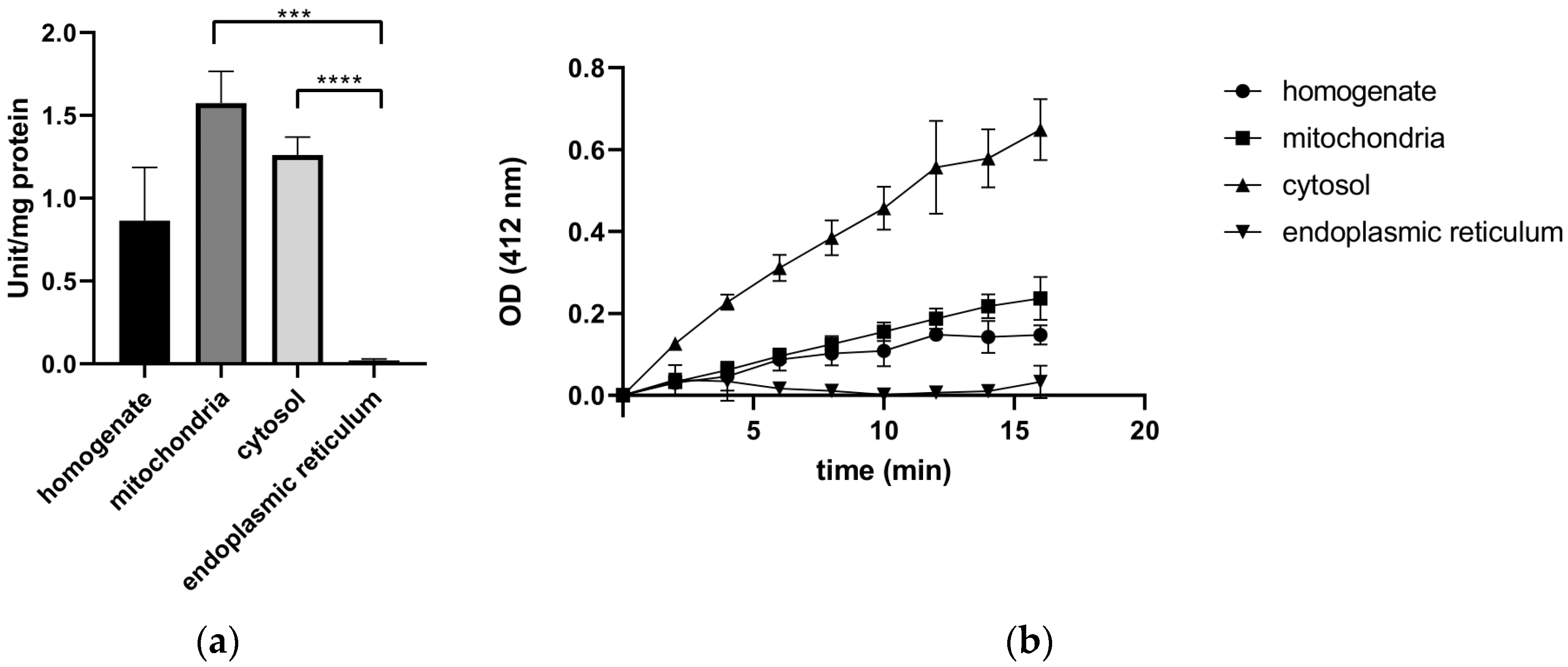
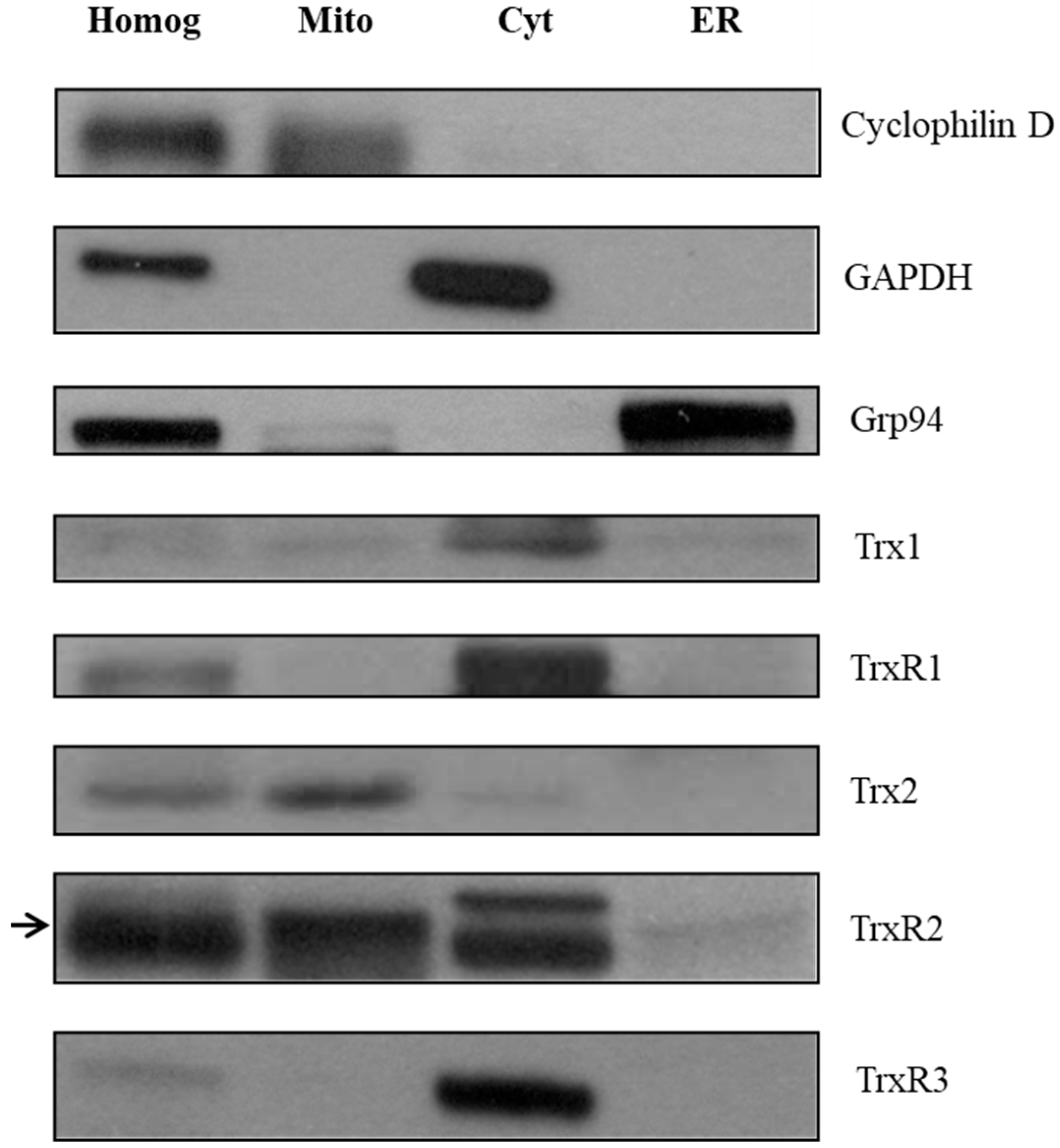


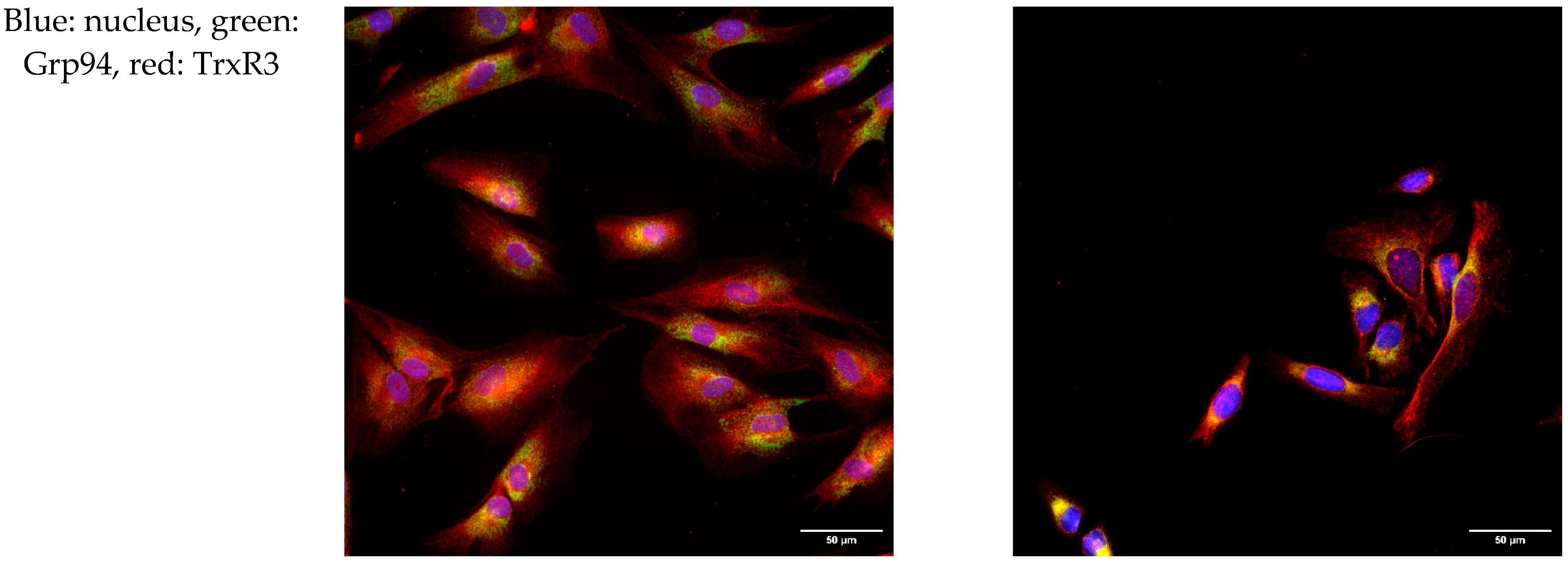
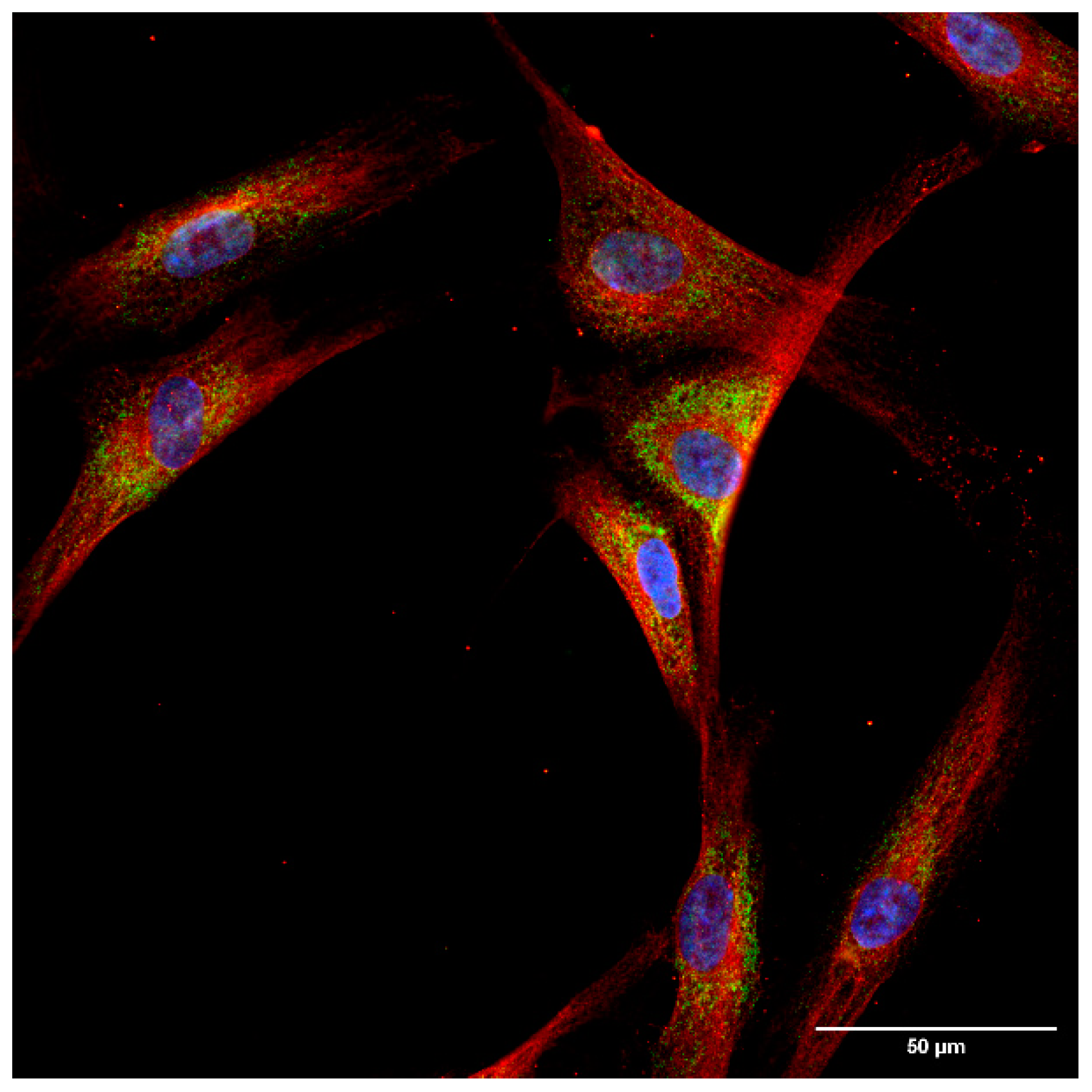
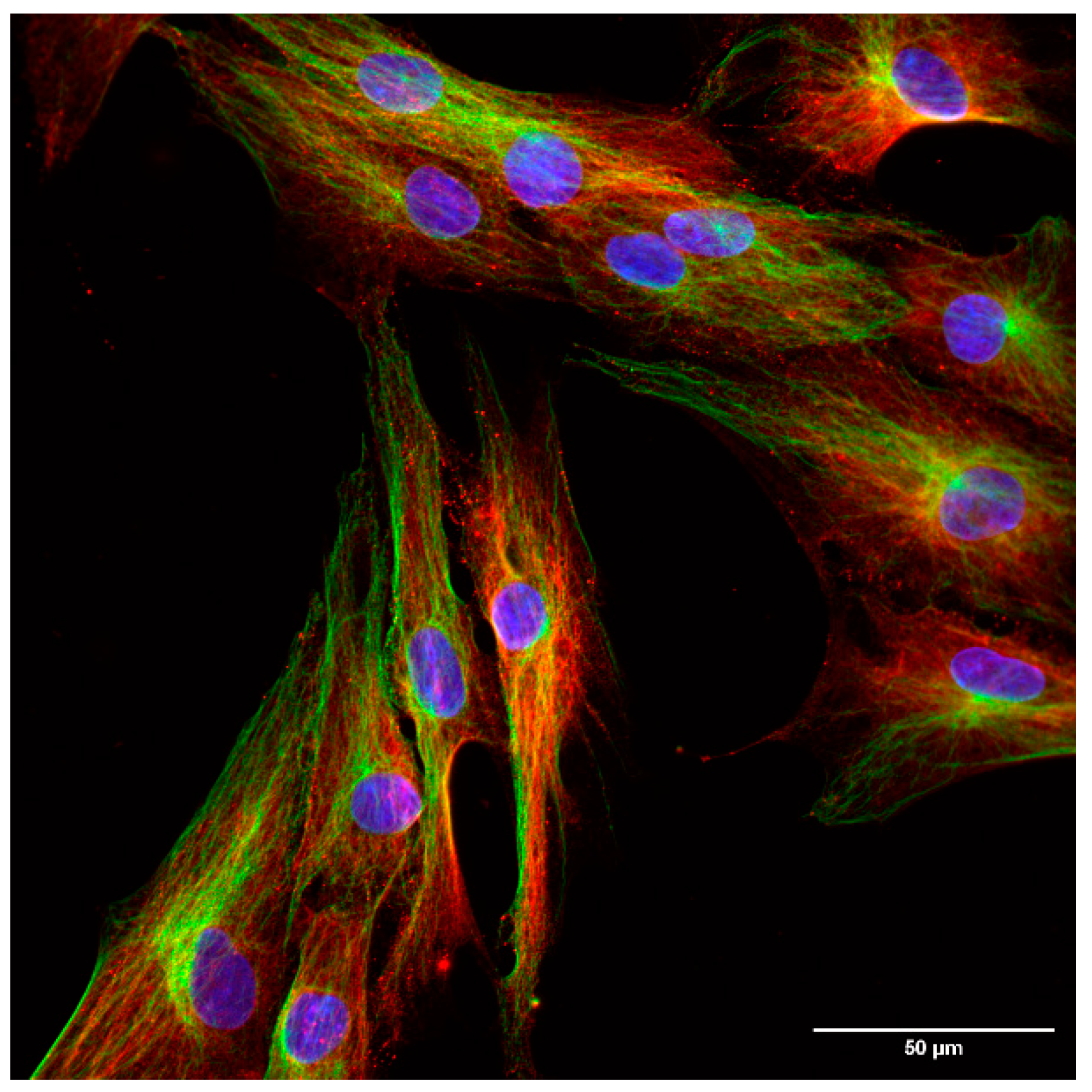
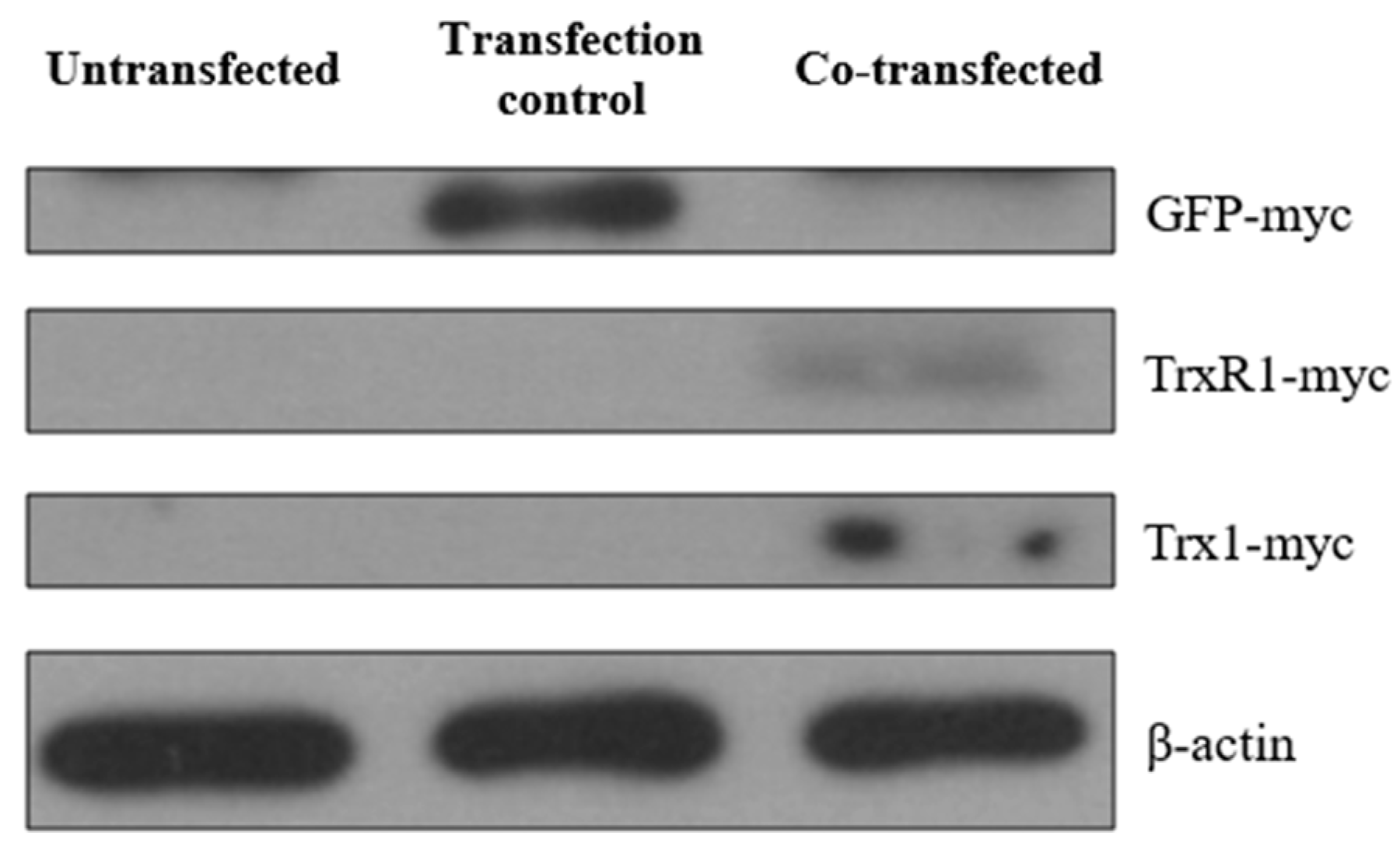
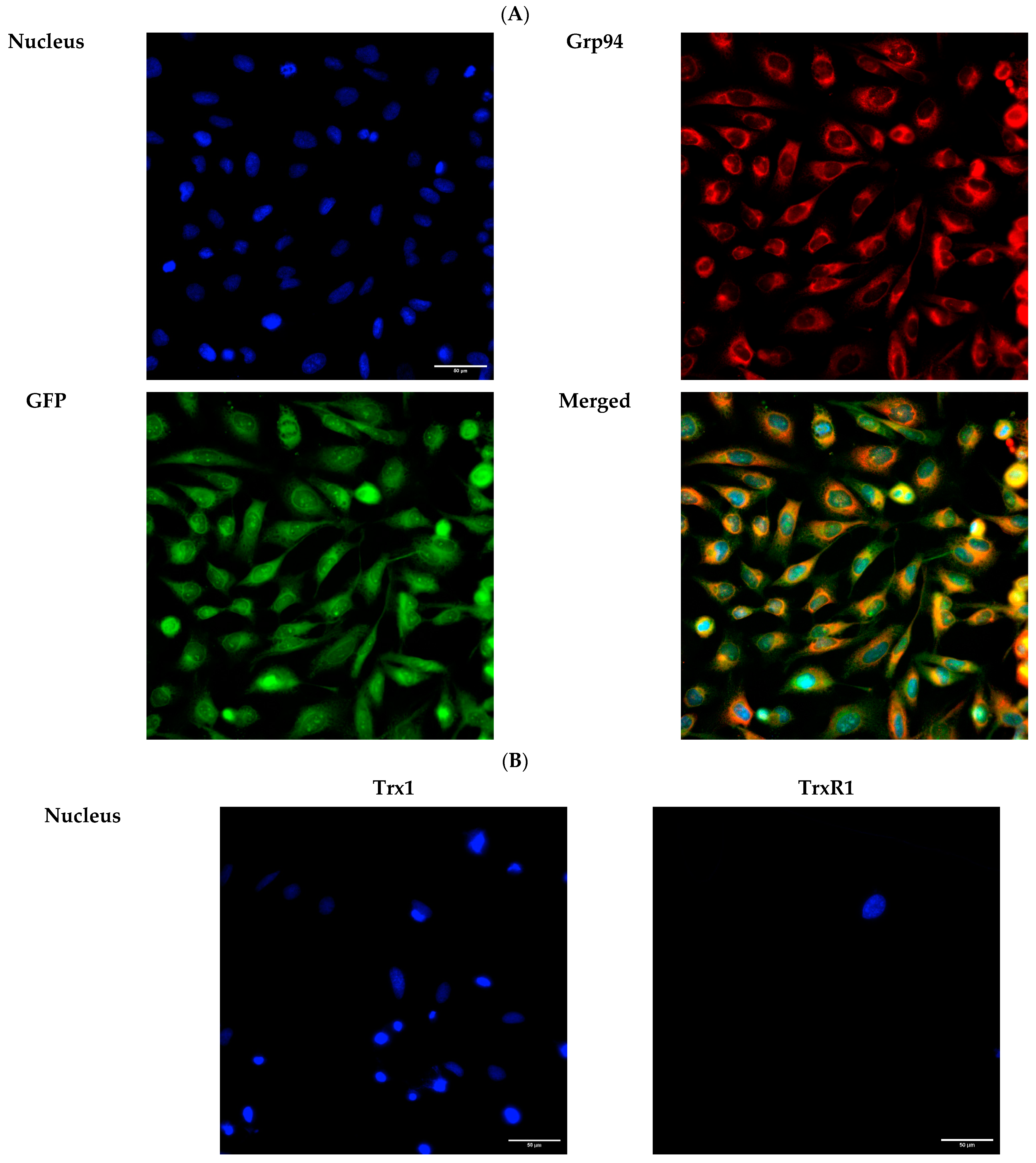

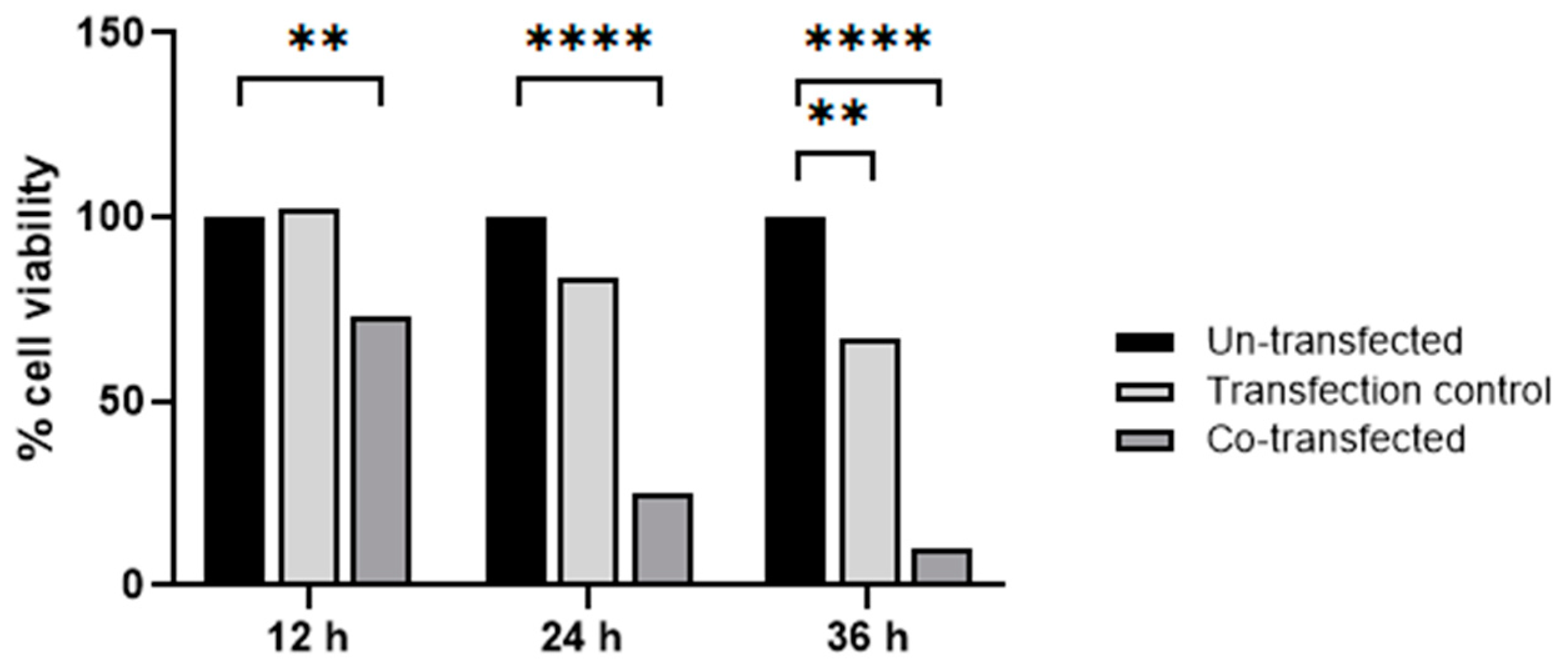
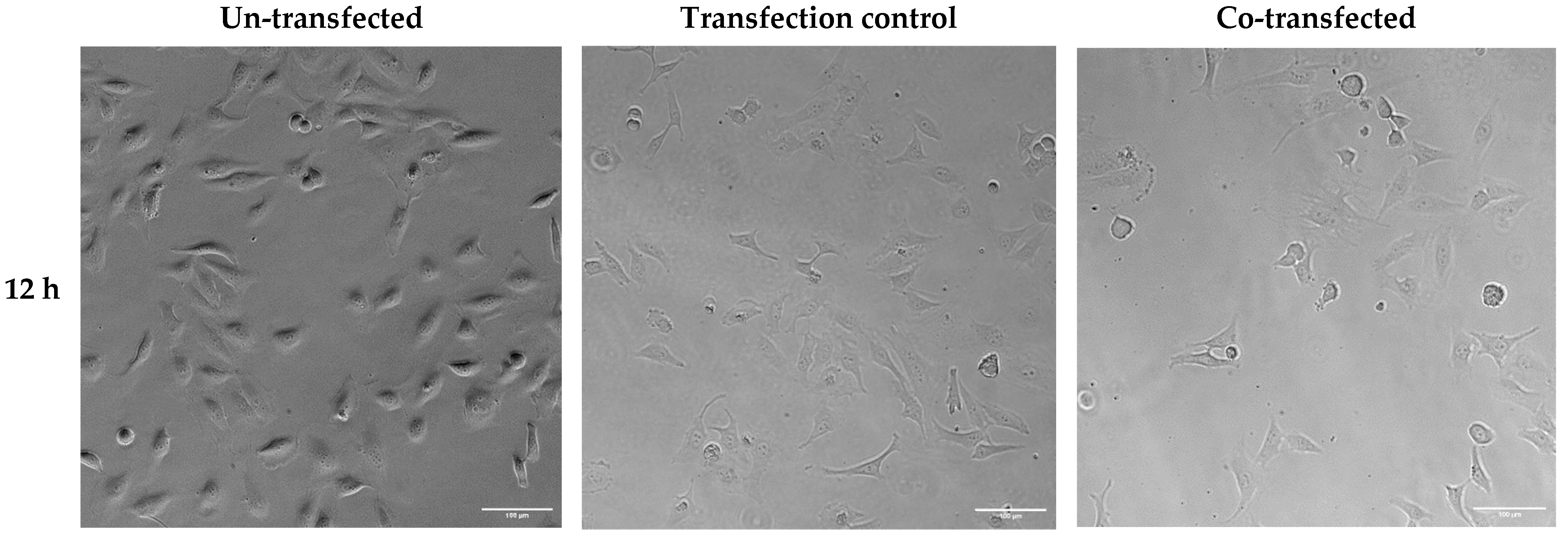
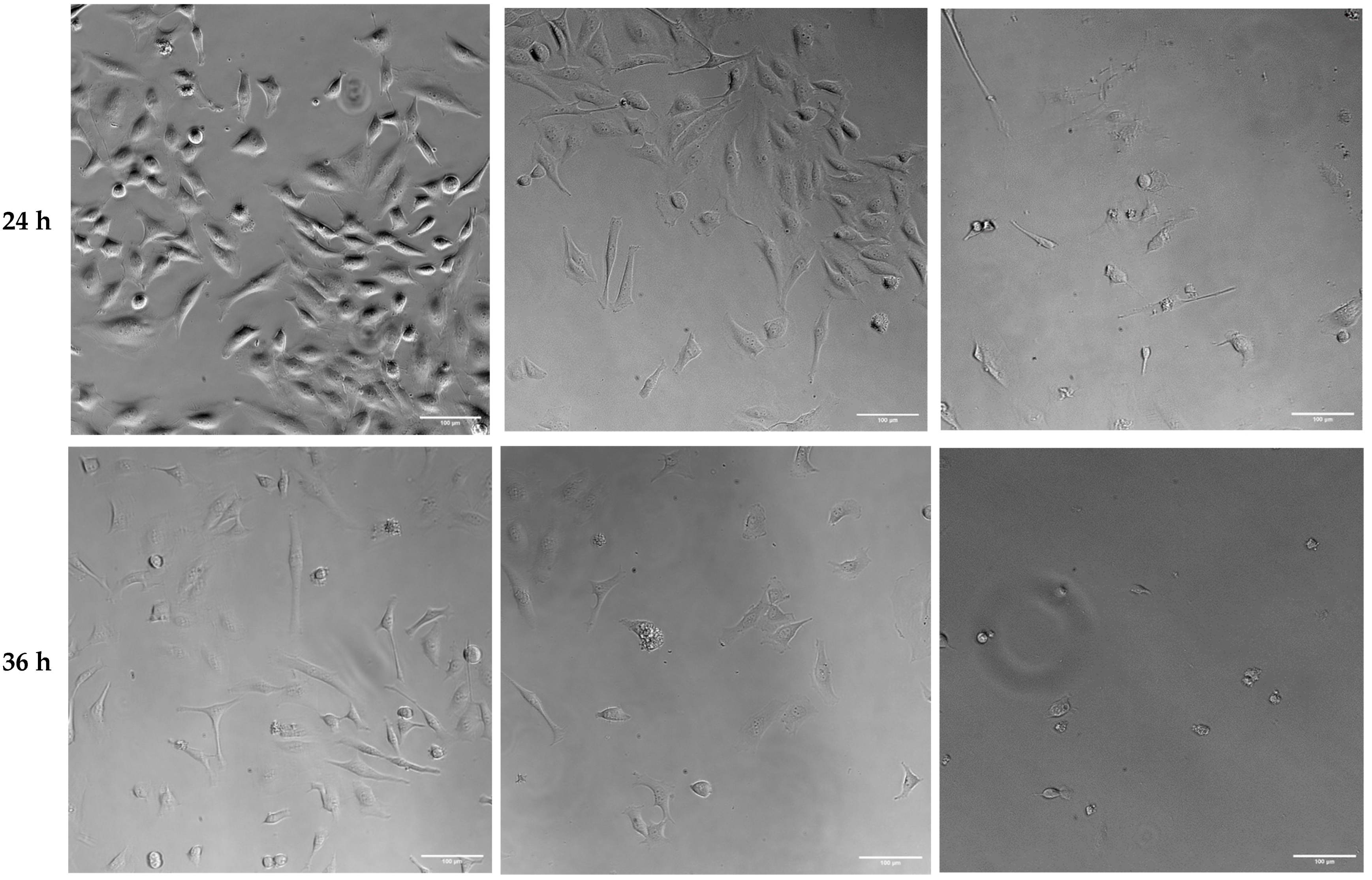
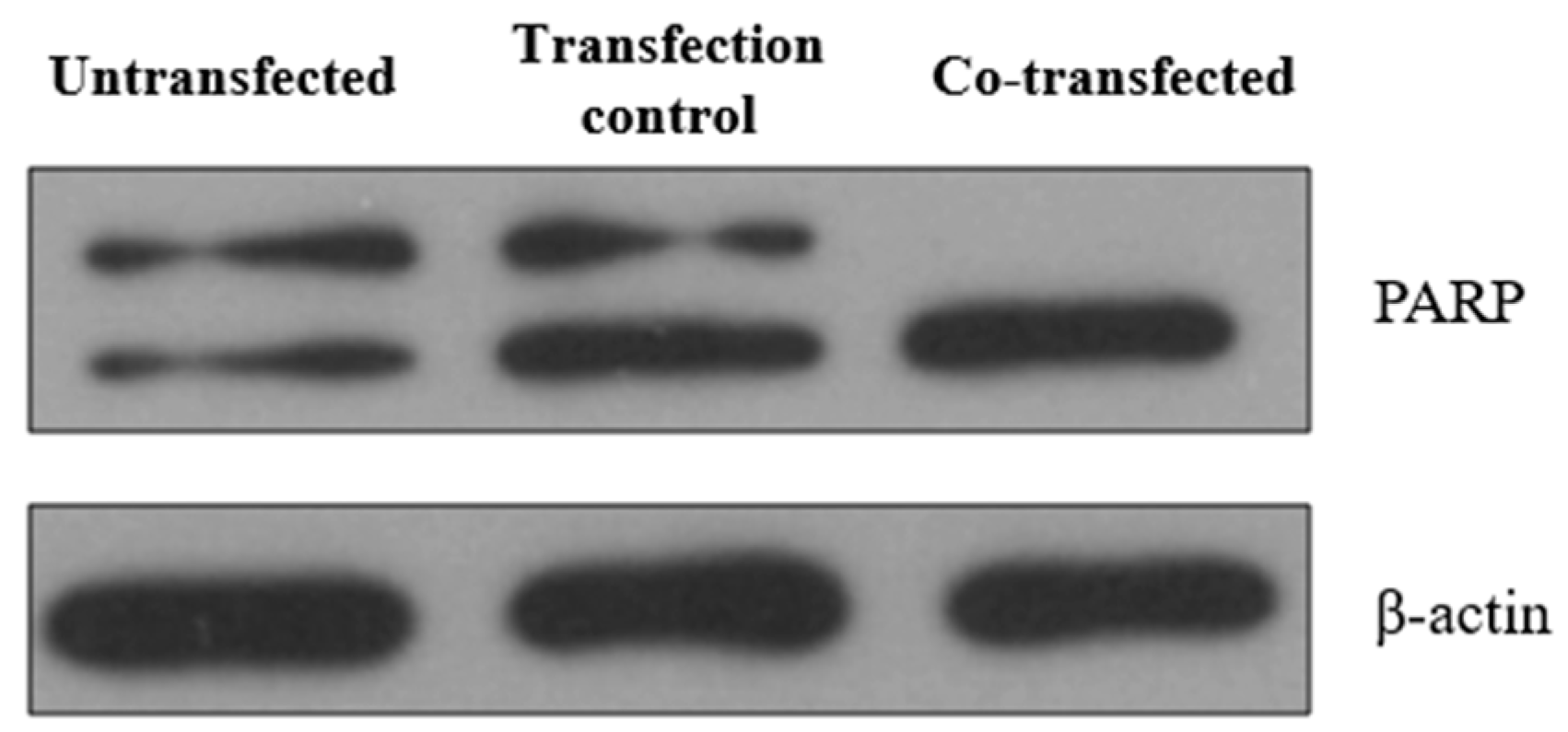
| Isoform | PSORT II | Predotar | Cello | MultiLoc2 | yLOC-HighRes | LocTree3 | DeepLoc-1.0 |
|---|---|---|---|---|---|---|---|
| Trx1 isoform_1 | - | 1% | 0.091 | 0% | 0.0% | - | 0.02% |
| Trx1 isoform_2 | - | 1% | 0.091 | 0% | 0.0% | - | 9.20% |
| Trx2_isoform 1 | - | 1% | 0.015 | 0% | 0.0% | - | 0.00% |
| Trx2_isoform 2 † | 4.3% | - | 0.031 | 0% | 0.0% | - | 0.19% |
| Trx2_isoform 3 † | 4.3% | 1% | 0.059 | 0% | 0.0% | - | 0.06% |
| TrxR1_isoform 1 | - | 1% | 0.031 | 0% | 0.0% | - | 1.70% |
| TrxR1_isoform 2 | - | 1% | 0.031 | 0% | 0.0% | - | 0.00% |
| TrxR1_isoform 3 | - | 1% | 0.020 | 0% | 0.0% | - | 0.26% |
| TrxR1_isoform 4 | - | 1% | 0.034 | 0% | 0.0% | - | 0.37% |
| TrxR1_isoform 5 | - | 1% | 0.030 | 0% | 0.0% | - | 1.25% |
| TrxR1_isoform 6 | - | 6% | 0.030 | 1% | 1.6% | - | 0.04% |
| TrxR1_isoform 7 | - | 1% | 0.033 | 0% | 0.0% | - | 1.63% |
| TrxR1_isoform 8 † | - | 1% | 0.022 | 1% | 0.0% | - | 0.00% |
| TrxR1_isoform 9 † | - | 1% | 0.033 | 0% | 0.0% | - | 1.02% |
| TrxR1_isoform 10 † | - | 1% | 0.034 | 0% | 0.2% | - | 1.78% |
| TrxR1_isoform 11 † | - | 1% | 0.030 | 0% | 0.0% | - | 1.69% |
| TrxR1_isoform 12 † | - | 1% | 0.038 | 0% | 0.0% | - | 0.70% |
| TrxR1_isoform 13 † | - | 1% | 0.032 | 0% | 0.0% | - | 1.62% |
| TrxR2_isoform 1 | - | 1% | 0.026 | 0% | 0.0% | - | 0.00% |
| TrxR2_isoform 2 | - | 1% | 0.026 | 0% | 0.0% | - | 0.56% |
| TrxR2_isoform 3 | - | 1% | 0.040 | 0% | 0.0% | - | 1.25% |
| TrxR2_isoform 4 | - | 1% | 0.030 | 0% | 0.0% | - | 0.49% |
| TrxR2_isoform 5 † | - | 1% | 0.026 | 0% | 0.0% | - | 2.11% |
| TrxR2_isoform 6 † | - | 1% | 0.026 | 0% | 0.0% | - | 1.15% |
| TrxR2_isoform 7 † | - | 1% | 0.025 | 0% | 0.0% | - | 0.00% |
| TrxR2_isoform 8 † | - | 1% | 0.022 | 0% | 0.0% | - | 0.00% |
| TrxR3_isoform 1 | 4.3% | 1% | 0.037 | 0% | 0.0% | - | 0.98% |
| TrxR3_isoform 2 † | 4.3% | - | 0.037 | 0% | 0.0% | - | 0.90% |
| TrxR3_isoform 3 † | 4.3% | 1% | 0.029 | 0% | 0.0% | - | 0.60% |
| Localization | PSORT II | Predotar | Cello | MultiLoc2 | yLOC-HighRes | LocTree3 | DeepLoc-1.0 |
|---|---|---|---|---|---|---|---|
| Plasma membrane | - | - | 0.122 | 0% | 0.0% | - | 1.79% |
| Endoplasmic reticulum | 4.3% | 1% | 0.029 | 0% | 0.0% | - | 0.60% |
| Extracellular | - | - | 0.253 | 0% | 0.0% | - | 1.70% |
| Lysosome | - | - | 0.026 | 0% | 0% | - | 0.93% |
| Golgi | - | - | 0.021 | 0% | 0.0% | - | 0.35% |
| Peroxysome | 4.3% | - | 0.271 | 30% | 2.6% | - | 16.43% |
| Mitochondria | 17.4% | 1% | 1.401 | 10% | 0.8% | - | 11.35% |
| Cytosol | 43.5% | - | 1.248 | 58% | 96.6% | 100% | 57.91% |
| Nucleus | 21.7% | - | 0.735 | 2% | 0.0% | - | 4.25% |
Disclaimer/Publisher’s Note: The statements, opinions and data contained in all publications are solely those of the individual author(s) and contributor(s) and not of MDPI and/or the editor(s). MDPI and/or the editor(s) disclaim responsibility for any injury to people or property resulting from any ideas, methods, instructions or products referred to in the content. |
© 2024 by the authors. Licensee MDPI, Basel, Switzerland. This article is an open access article distributed under the terms and conditions of the Creative Commons Attribution (CC BY) license (https://creativecommons.org/licenses/by/4.0/).
Share and Cite
Veszelyi, K.; Czegle, I.; Varga, V.; Németh, C.E.; Besztercei, B.; Margittai, É. Subcellular Localization of Thioredoxin/Thioredoxin Reductase System—A Missing Link in Endoplasmic Reticulum Redox Balance. Int. J. Mol. Sci. 2024, 25, 6647. https://doi.org/10.3390/ijms25126647
Veszelyi K, Czegle I, Varga V, Németh CE, Besztercei B, Margittai É. Subcellular Localization of Thioredoxin/Thioredoxin Reductase System—A Missing Link in Endoplasmic Reticulum Redox Balance. International Journal of Molecular Sciences. 2024; 25(12):6647. https://doi.org/10.3390/ijms25126647
Chicago/Turabian StyleVeszelyi, Krisztina, Ibolya Czegle, Viola Varga, Csilla Emese Németh, Balázs Besztercei, and Éva Margittai. 2024. "Subcellular Localization of Thioredoxin/Thioredoxin Reductase System—A Missing Link in Endoplasmic Reticulum Redox Balance" International Journal of Molecular Sciences 25, no. 12: 6647. https://doi.org/10.3390/ijms25126647
APA StyleVeszelyi, K., Czegle, I., Varga, V., Németh, C. E., Besztercei, B., & Margittai, É. (2024). Subcellular Localization of Thioredoxin/Thioredoxin Reductase System—A Missing Link in Endoplasmic Reticulum Redox Balance. International Journal of Molecular Sciences, 25(12), 6647. https://doi.org/10.3390/ijms25126647






